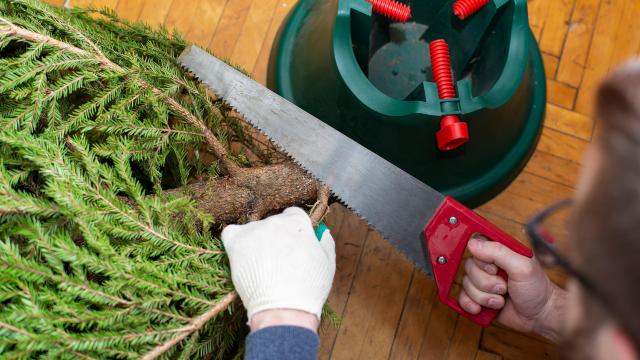A live Christmas tree would seem to be a fine project for somebody with a brown thumb. You only have to tend it for a month, and then it’ll get chucked to the curb. But it’s important to keep your tree fresh and happy during that time, lest it turn into a fire hazard.
Unfortunately, bogus “hacks” abound that will actually make your tree more likely to lose their needles. Let’s separate the myths from the actual good advice.
Don’t put anything in the water
It seems like everybody has their own special recipe for “preserving” their Christmas tree. But if you talk to the experts on keeping cut trees alive — like the horticulturists at cooperative extensions, and the National Christmas Tree Association — they all agree that the best thing to put in your tree stand is plain water. Nothing added.
Take this study, for example. A forestry specialist placed fresh cut Christmas tree branches into water treated with a variety of things that are supposed to make trees last longer. These included tree preservatives you can buy at stores, as well as common DIY solutions involving corn syrup and bleach.
All of the additives resulted in the branches losing more needles than if they had just been in plain water. Similar studies have been done with other additives, including 7-Up soda, but plain ol’ water wins every time.
Don’t cut your tree trunk into clever shapes
If you’re used to cutting flower stems at an angle before putting them into a vase, you might think it’s helpful to do the same for your Christmas tree’s trunk.
But that doesn’t actually help the tree to absorb more water, and can actually make the tree less healthy, experts say.
“Drilling a hole in the base of the trunk does not improve water uptake,” the National Christmas Tree Association says. Washington State University warns that cutting at an angle whittling the base of a tree can “seriously impede” the ability of the tree to take up water.
What to do instead? Make a flat cut across the bottom of the trunk before you plop it into its stand or bucket of water. You only need to take off about a 1/2″ disc, and you only need to do this if it’s been 6 to 12 hours since the tree was cut. That means if you cut your own at a tree farm, you can just drive it home and put it in a bucket without any trimming.
Don’t half-arse the watering
Christmas trees need a lot of water. Before you even put the tree in the stand, figure out whether the stand can even hold enough.
The rule of thumb is that the tree will drink a quart of water per day per inch of trunk diameter. So if the trunk is 4 inches wide, it will go through a full gallon of water every day.
This can vary from tree to tree, of course. And even though you really shouldn’t let your pets drink the tree water, you should give the tree extra water if you notice it disappearing faster than expected.
Make sure to check your tree at least twice a day to be sure it has plenty of water. (This goes double if your tree is near a heating vent or uses old-fashioned lights that give off a lot of heat.) You can even buy an automatic waterer, or create your own siphon-and-bucket hack for when you’re travelling. Just don’t let the tree dry out.
Don’t assume that every tree at the store is fresh
The last tip I’ll give you is the first one you should know when shopping: if the tree is already starting to dry out when it’s at the store, pass it up. And if all the trees at a Christmas tree lot show signs of drying out, you should shop elsewhere.
The easiest way to check is to grab a branch and pull your hand toward you. The needles should stay firmly attached to the tree, and not come off en masse in your hand.
You can also try bending a needle to see if it breaks. The needles on pine trees shouldn’t break at all. The needles on fir and spruce trees will snap if you bend them enough — like what you would expect from bending a carrot — but they shouldn’t feel dry and brittle.
Finally, pick the tree up and tap the trunk on the ground a few times. If a few brown needles fall out, that’s fine — the tree equivalent of finding a few hairs in your hairbrush. But if still-green needles are raining down, that’s not a tree that will last. As a bonus, tapping the tree like this will reduce the number of needles you’ll have to vacuum up when you set up the tree.

Leave a Reply
You must be logged in to post a comment.